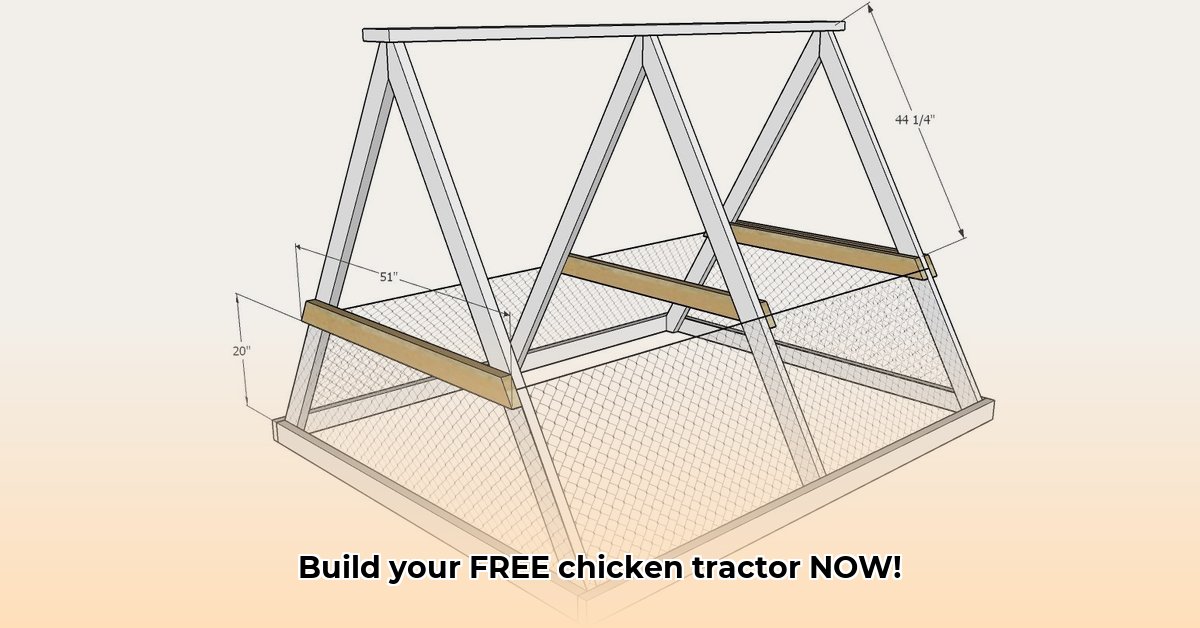
Want fresh, farm-fresh eggs daily and happy, healthy chickens? Building your own A-frame chicken tractor is easier than you think! This guide provides two distinct plans: a robust, predator-proof design and a simpler, quicker-to-build option. We'll walk you through each step, covering materials, tools, and troubleshooting, empowering you to create the perfect chicken tractor, saving money and providing your hens with a fantastic, mobile home. Let's get started! For pre-made kits, check out these options.
Choosing Your Approach: Fortress or Easy Rider?
Before you grab your tools, let's compare these two approaches. This table highlights the pros and cons of each design, helping you determine the best fit for your skills and resources. Do you prioritize ultimate predator protection or a faster, simpler build?
| Feature | Fortress Design (Predator-Proof) | Easy Rider Design (Simple & Fast) |
|---|---|---|
| Predator Protection | Excellent; virtually impenetrable chicken fortress! | Good; location and supplementary measures enhance protection. |
| Building Time | A weekend project, possibly longer depending on experience. | A shorter project, potentially achievable in a long afternoon. |
| Materials Cost | Higher; requires more durable, heavier-duty materials. | Lower; utilizes readily available, less expensive materials. |
| Durability | Built to last for years; withstanding the test of time. | Functional for several years; lifespan depends on construction and materials. |
| Skill Level | Moderate DIY experience beneficial; involves power tools. | Beginner-friendly; ideal for first-time DIYers. |
Detailed Plans: The Fortress (Predator-Proof Design)
This design focuses on maximum security, keeping your hens safe from predators. It's a more involved project, requiring more time and materials, but the enhanced safety is worth the effort.
Materials:
- Pressure-treated lumber (rot and insect resistant)
- Heavy-duty galvanized steel wire mesh (prevents predator intrusion)
- Strong wheels and axles (capable of handling the coop's weight)
- Sturdy latches and hinges (ensure secure closures)
- Screws, nails, and other assorted hardware
Tools:
- Circular saw (or hand saw)
- Drill
- Screwdriver
- Measuring tape
- Level
- Safety glasses
- Work gloves
Step-by-Step Instructions:
- Cut the Lumber: Precisely cut the lumber according to your chosen plans. Accurate cuts are crucial for structural integrity.
- Assemble the Frame: Construct the A-frame, ensuring a sturdy and square structure. Use ample screws and/or nails for secure connections.
- Attach the Wheels: Securely affix the wheels to the bottom, ensuring smooth movement.
- Install the Wire Mesh: Attach the wire mesh, leaving no gaps for predator entry.
- Add Doors and Latches: Build and install secure doors with strong latches for easy access.
Detailed Plans: The Easy Rider (Simple Design)
This simpler design prioritizes speed and ease of construction, perfect for beginners. While offering good protection, it may require additional safety measures depending on your location and the prevalence of predators.
Materials:
- Untreated lumber (cedar recommended for natural rot resistance, otherwise use treated lumber)
- Hardware cloth (less heavy-duty than galvanized steel mesh)
- Simple wheels and axles
Tools: Similar tools to the Fortress design, but fewer specialized tools may be needed.
Step-by-Step Instructions:
- Cut the Lumber: Cut lumber according to your chosen plans.
- Construct the Basic Frame: Build a simpler A-frame or rectangular structure.
- Add Wheels and Hardware Cloth: Attach wheels and secure the hardware cloth to the frame.
- Add a Simple Door: Create a basic access point.
Troubleshooting & Maintenance: Keeping Your Tractor Rolling
Regular maintenance ensures your chicken tractor remains functional and safe.
- Wheels: Inspect regularly for wear and tear; lubricate as needed.
- Mesh/Hardware Cloth: Promptly repair any tears or holes to prevent predator access or chicken escapes.
- Wood: Check for rot or insect damage; treat as necessary, especially for untreated wood.
Legal Considerations
Before construction, verify local regulations regarding chicken ownership and backyard structures. Your local authorities can provide necessary guidelines.
Conclusion: Start Your Project Today!
Building your own A-frame chicken tractor offers significant benefits, from fresh eggs to improved soil health through movable pasture rotation. Choose the plan that best suits your needs and skills, and enjoy the rewarding experience of building a functional and sustainable chicken home! Happy building!